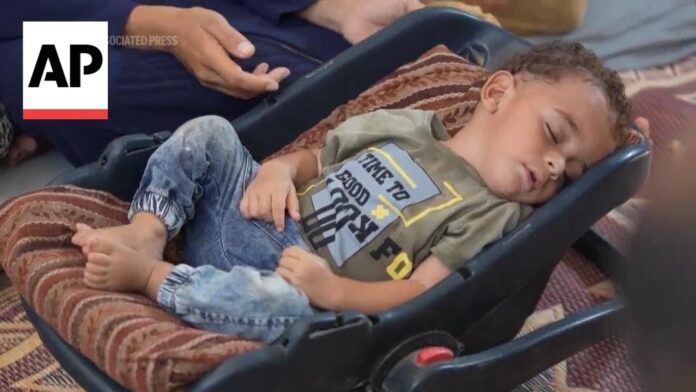An 11-month-old boy in Gaza becomes the first confirmed polio case in the region in a quarter-century, amid deteriorating health conditions
In a troubling development, Gaza has reported its first polio case in 25 years, with an 11-month-old boy, Abdul Rahman Abu Al-Jidyan, diagnosed with the disease in August. The World Health Organization (WHO) confirmed the case, highlighting a significant health crisis in the region, exacerbated by ongoing conflict and deteriorating sanitation conditions.
Abdul Rahman, who is not yet vaccinated against polio, shows severe symptoms of the disease. His mother, Nafin Abu Al-Jidyan, observed that her son’s left leg remains motionless while the rest of his body struggles to move. The child’s condition is a stark reminder of the virus’s devastating impact, as Abdul Rahman has difficulty crawling and walking, and his neck and limbs show signs of paralysis.
Polio, a preventable disease, spreads through contact with contaminated food, water, or respiratory droplets. While most cases resolve without severe complications, about one percent of infections can lead to permanent paralysis and muscle weakness. The diagnosis of Type 2 poliovirus in Gaza comes as a serious setback, especially given that the region had previously eradicated the disease.
In response to the crisis, the Israel Defence Forces (IDF) initiated a vaccine booster campaign for Israeli troops in Gaza and committed to providing vaccines for Palestinians through aid organizations. This effort aims to curb the virus’s spread following the detection of Type 2 poliovirus in Gaza’s wastewater in July. The IDF reported that sufficient vaccine doses for 640,000 children have been introduced into Gaza, tailored to the virus identified in environmental samples.
The situation in Gaza is dire, described as “absolutely catastrophic” by Tess Ingram, a UNICEF spokesperson. The current conflict and destruction have severely impacted Gaza’s sanitation infrastructure, leading to a substantial decrease in polio vaccination rates. Before the outbreak of conflict, vaccination coverage was near 99%, but it has now fallen below 90% due to the war’s disruptions and the displacement of nearly 1.9 million people.
Nafin Abu Al-Jidyan suspects that poor sanitation contributed to her son’s illness, as Abdul Rahman was exposed to dirty environments and potentially contaminated water. His initial symptoms included fever and vomiting, leading to a diagnosis of polio after tests confirmed the presence of Type 2 poliovirus.
The Gaza Strip’s health crisis is compounded by the ongoing conflict, which has resulted in extensive damage to healthcare facilities. The current war between Hamas and Israel has led to significant casualties and further deterioration of living conditions in Gaza. The region’s healthcare system struggles to cope with the additional burden of a polio epidemic amid widespread displacement and infrastructure damage.
As Abdul Rahman approaches his first birthday, his family remains hopeful that he may receive better medical care abroad. The family, displaced multiple times due to the conflict, faces isolation and fear of the virus’s spread. Nafin and her husband worry about the future of their son and the impact of polio on his life.
Analysis:
Political:
The polio outbreak in Gaza highlights the intersection of public health and geopolitical conflict. The ongoing war between Hamas and Israel exacerbates the health crisis, impeding vaccination efforts and access to healthcare. The Israeli military’s involvement in vaccine distribution reflects the complex political dynamics affecting aid delivery in conflict zones. The crisis underscores the need for stable governance and international cooperation to address health emergencies in war-torn regions.
Social:
The emergence of polio in Gaza amidst the conflict reveals the profound social impacts of war on public health. The displacement of families and the destruction of sanitation infrastructure create conditions conducive to disease outbreaks. The health crisis exacerbates existing social challenges, including inadequate healthcare and poor living conditions. The stigma associated with polio and the isolation faced by affected families further compound the social difficulties.
Racial:
Polio’s resurgence in Gaza underscores broader racial and ethnic disparities in healthcare access. The conflict disproportionately affects Palestinian communities, revealing systemic inequities in health infrastructure and response. The international response to the outbreak may reflect global disparities in the attention and resources allocated to different regions based on geopolitical interests.
Gender:
The impact of the polio outbreak on gender dynamics is significant. Women, particularly mothers, bear the brunt of caregiving responsibilities in crisis situations. Nafin Abu Al-Jidyan’s experience highlights the added burden on women in conflict zones, who must navigate healthcare challenges and support their families under extreme conditions. The broader impact on children, especially girls and boys in displaced families, reflects the gendered effects of health crises.
Economic:
The economic repercussions of the polio outbreak in Gaza are substantial. The destruction of healthcare infrastructure and the increased burden on limited resources strain Gaza’s already fragile economy. The cost of medical care and vaccination efforts, combined with the loss of productivity due to illness, further impacts the region’s economic stability. The conflict exacerbates these issues, disrupting economic activities and worsening living conditions for the population.
